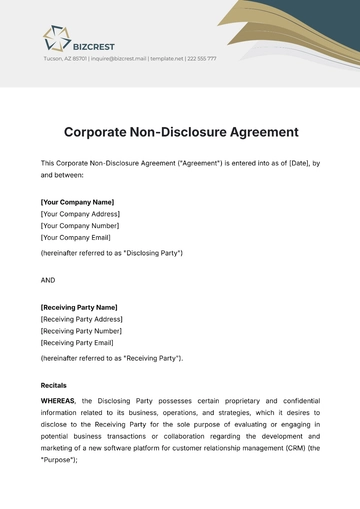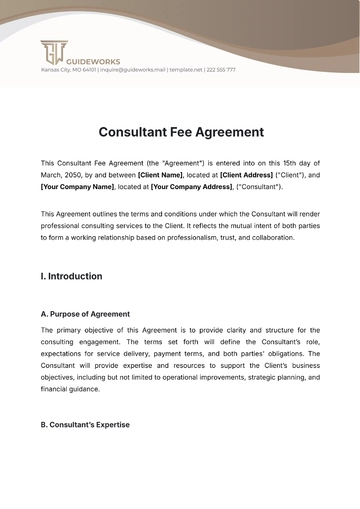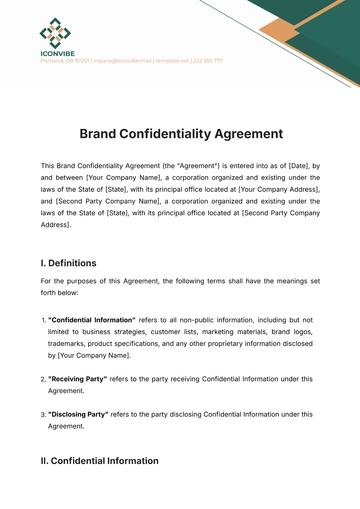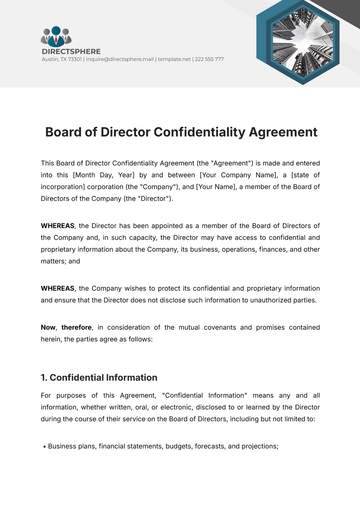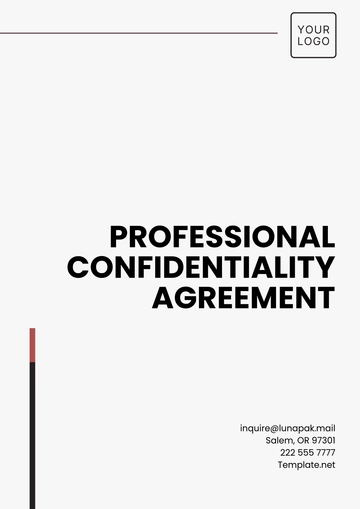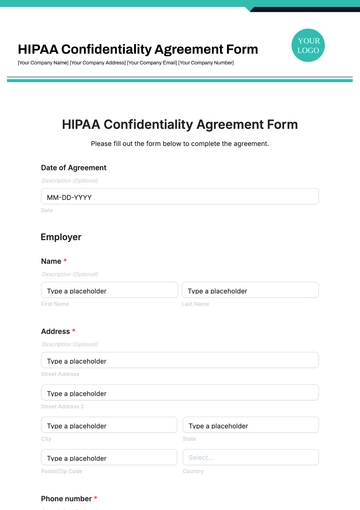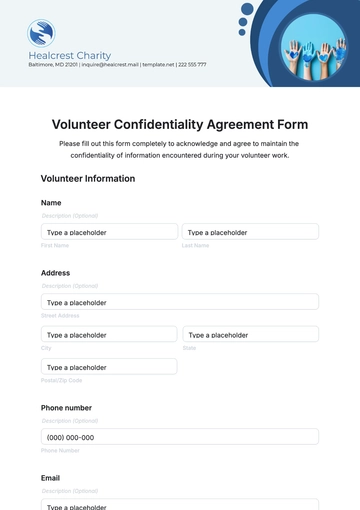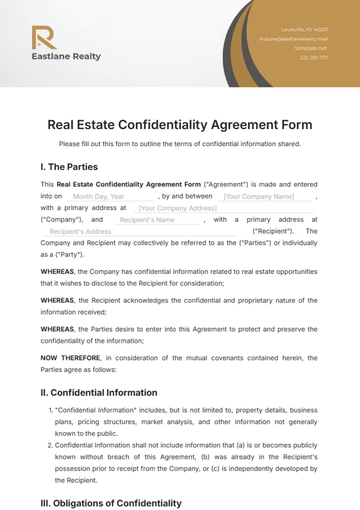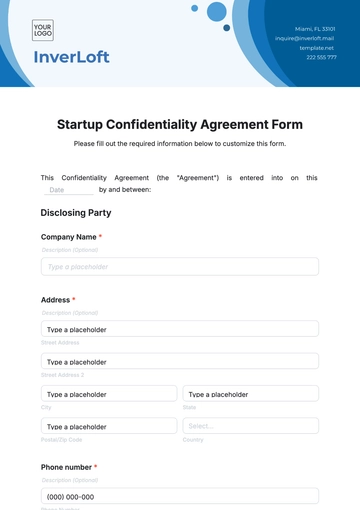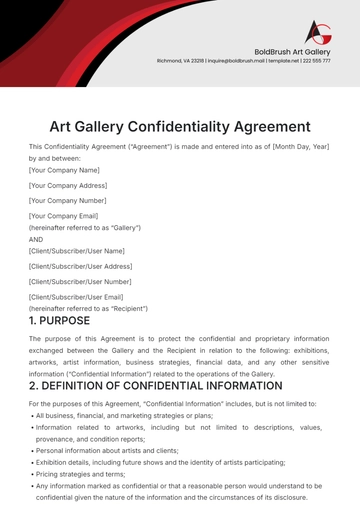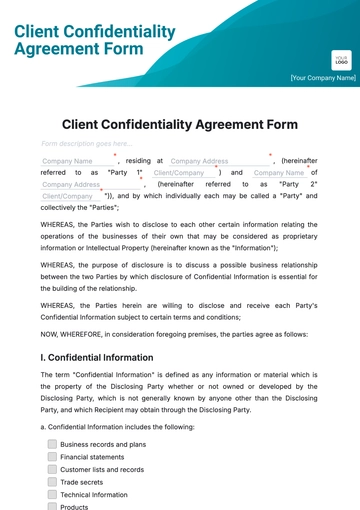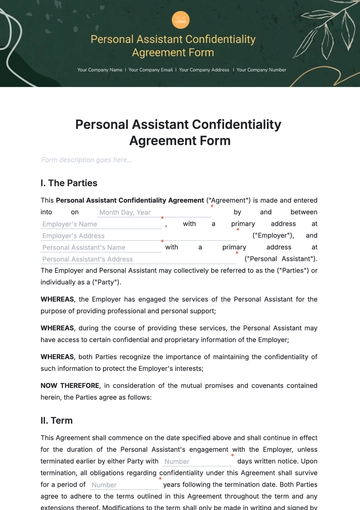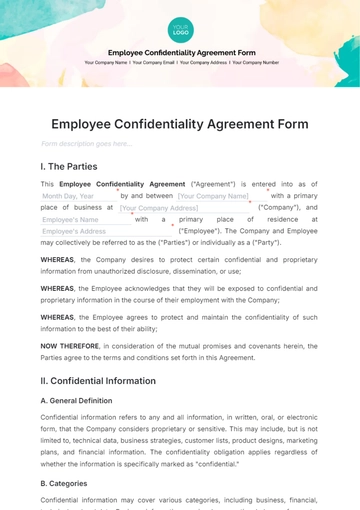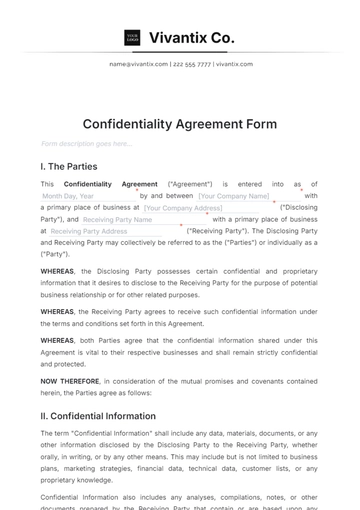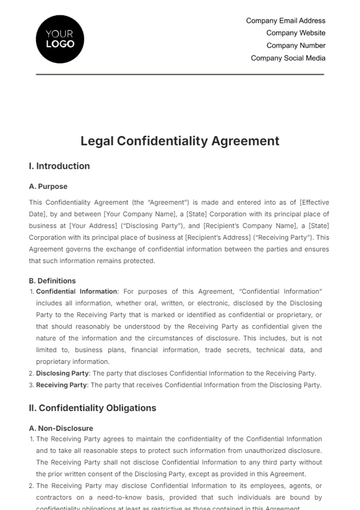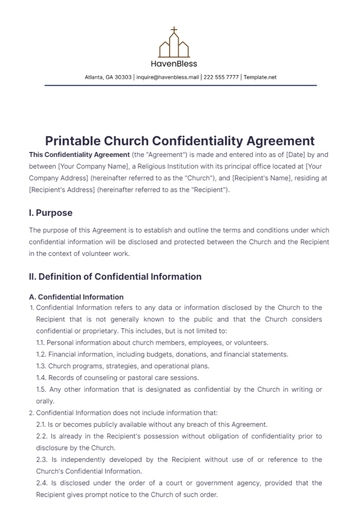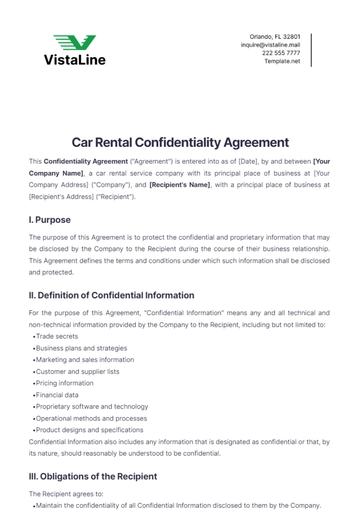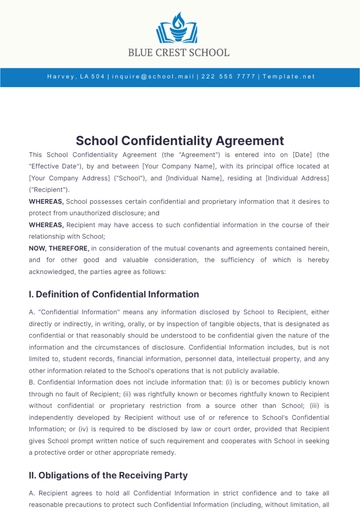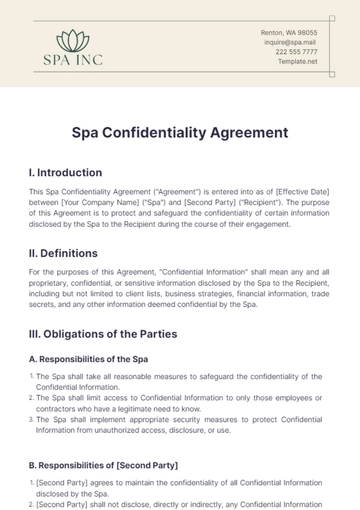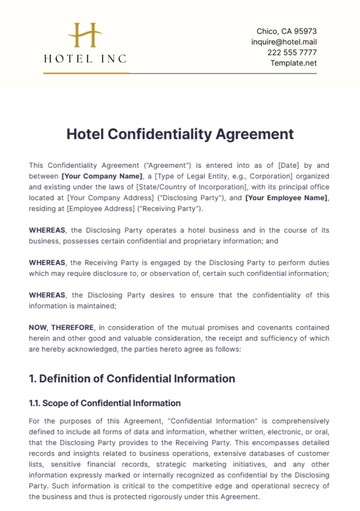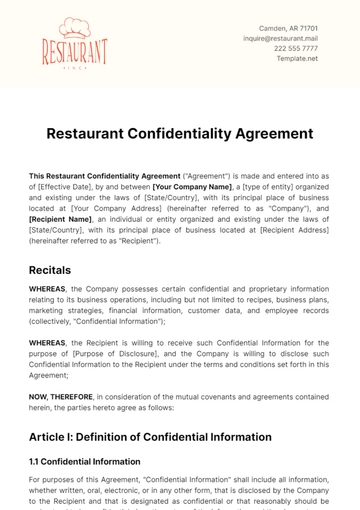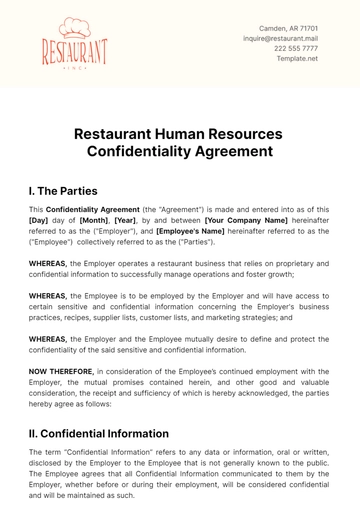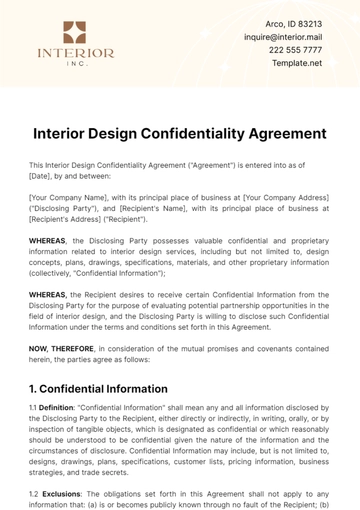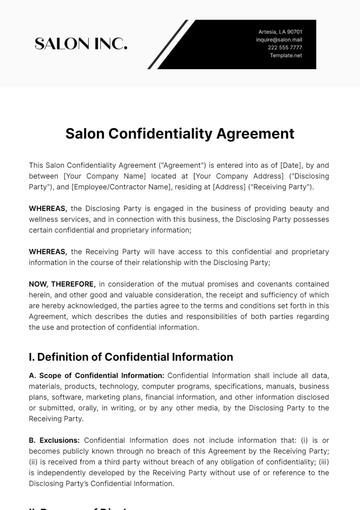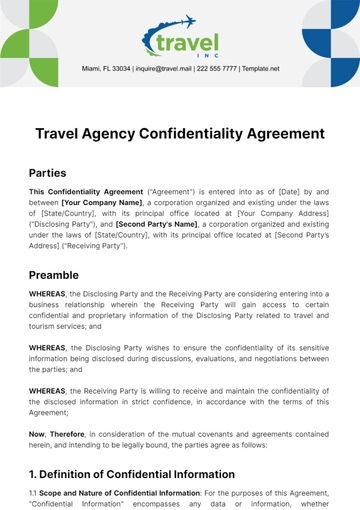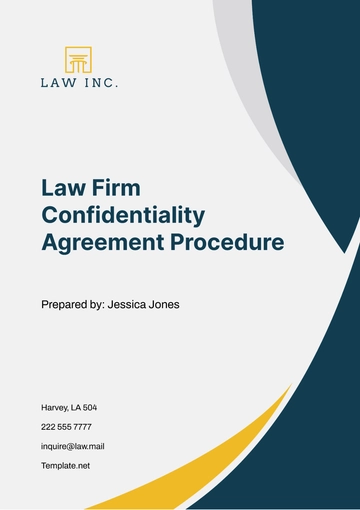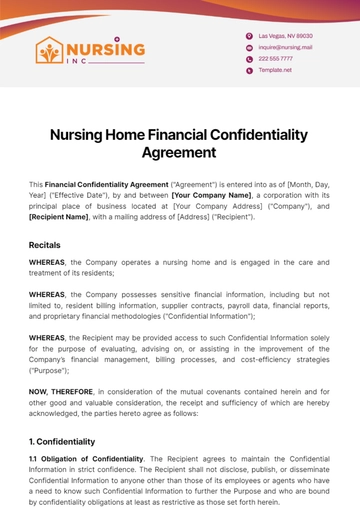Free Law Firm Confidentiality Agreement Procedure
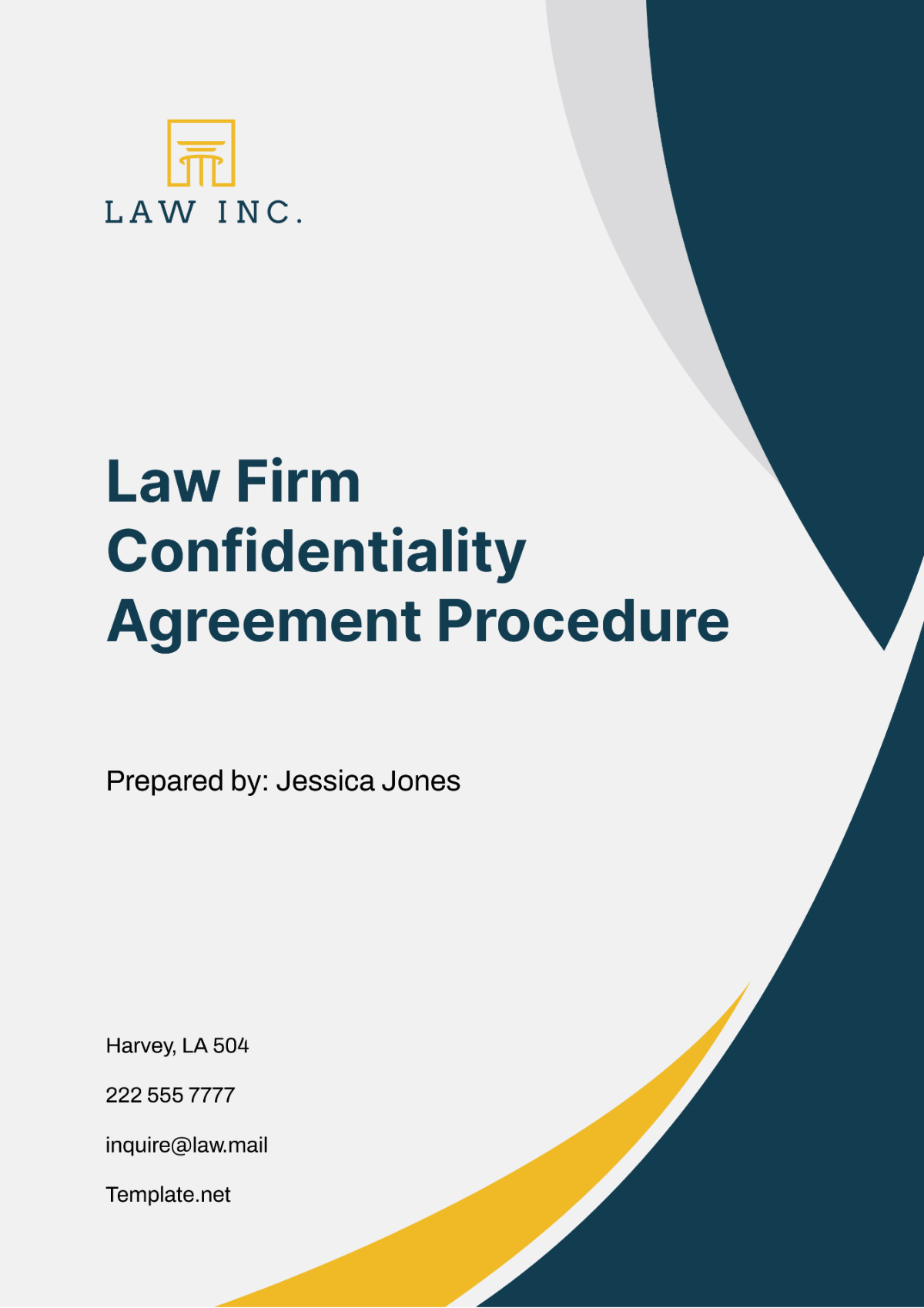
I. Introduction
A. Purpose
The purpose of this Confidentiality Agreement Procedure is to ensure that all confidential information handled by [Your Company Name] is protected and used appropriately. This procedure outlines the steps that must be followed when dealing with confidential information, from its receipt to its disposal. It is designed to safeguard the interests of our clients, our firm, and all individuals involved in our operations.
The procedure also aims to foster a culture of confidentiality within our firm. By adhering to this procedure, we can ensure that all team members understand the importance of confidentiality and are equipped with the knowledge and skills to handle confidential information responsibly.
B. Scope
The scope of this procedure is broad and encompasses various aspects of our operations:
Team Members: This procedure applies to all team members of [Your Company Name], including partners, associates, paralegals, administrative staff, and interns. It is crucial that everyone in our firm understands and adheres to our confidentiality standards.
Types of Information: The procedure covers all types of confidential information, including client information, case details, internal communications, and business strategies. This ensures that all sensitive information is handled with the utmost care.
All Stages of Information Handling: From the moment confidential information is received, through its use and storage, up to its eventual disposal, this procedure provides clear guidelines on how to handle such information.
External Communications: Any communication involving confidential information that leaves the firm, whether it’s with clients, other law firms, or third-party service providers, falls under the scope of this procedure.
Internal Communications: Even within the firm, the sharing and discussion of confidential information should be done in accordance with this procedure.
C. Definitions
Before we proceed, let’s define some terms that will be used in this procedure:
Confidential Information: Any information that is not publicly available and that has been disclosed to or obtained by [Your Company Name] in the course of its operations.
Client Information: Any information about a client that has been disclosed to or obtained by [Your Company Name] in the course of providing legal services.
Case Details: Specific information about a legal case that [Your Company Name] is handling.
Internal Communications: Communications between team members of [Your Company Name] that are not intended for public disclosure.
Business Strategies: Information about [Your Company Name]'s business plans, marketing strategies, financial data, and other proprietary information.
Disclosure: The act of making confidential information known to others.
Unauthorized Disclosure: The disclosure of confidential information without the necessary permissions or safeguards in place.
Confidentiality Agreement: A legal agreement that outlines the obligations of [Your Company Name] and its team members with respect to the handling of confidential information.
Data Protection: Measures taken to prevent unauthorized access to or disclosure of confidential information.
Data Breach: An incident where confidential information is accessed or disclosed without authorization.
II. Confidentiality Agreement
The Confidentiality Agreement is a critical component of our firm’s commitment to protecting confidential information. It outlines the obligations of all parties involved and provides a legal framework for the handling of confidential information. The following table provides an overview of the steps:
No. | Step | Description |
|---|---|---|
1 | Agreement Preparation | The Confidentiality Agreement is prepared, outlining the obligations and responsibilities of all parties involved. |
2 | Agreement Signing | All parties involved sign the Confidentiality Agreement, indicating their understanding and acceptance of its terms. |
3 | Agreement Storage | The signed Confidentiality Agreement is stored securely, ensuring its availability for future reference. |
A. Agreement Preparation
Drafting the Agreement: The Confidentiality Agreement is drafted by our legal team. The agreement is tailored to the specific needs of our firm and our clients, ensuring that all relevant aspects of confidentiality are covered.
Reviewing the Agreement: The draft agreement is reviewed by our senior management and legal team. This review ensures that the agreement is comprehensive, legally sound, and aligned with our firm’s values and objectives.
Finalizing the Agreement: Any necessary revisions are made to the draft agreement based on the review. Once all revisions have been made, the agreement is finalized and ready for signing.
Communicating the Agreement: The finalized agreement is communicated to all parties involved. This includes explaining the purpose of the agreement, its key terms, and the obligations it imposes.
Obtaining Acknowledgement: Before signing the agreement, all parties involved are asked to acknowledge that they understand the agreement and agree to its terms.
B. Agreement Signing
Arranging the Signing: A time and place for the signing of the agreement is arranged. This is done in a way that is convenient for all parties involved.
Conducting the Signing: At the arranged time and place, all parties involved sign the agreement. This is done in the presence of a witness, who also signs the agreement.
Verifying the Signing: The signed agreement is verified to ensure that all signatures are genuine and that the agreement has been signed correctly.
Acknowledging the Signing: Once the agreement has been signed and verified, all parties involved are given a copy of the signed agreement. They are also given an acknowledgement of the signing, which confirms that the agreement is now in effect.
C. Agreement Storage
Preparing for Storage: The signed agreement is prepared for storage. This includes making any necessary copies and ensuring that the agreement is in a suitable format for storage.
Storing the Agreement: The agreement is stored in a secure location. This location is accessible only to authorized personnel and is protected against potential threats such as fire, theft, and damage.
Maintaining the Storage: The storage location is regularly maintained to ensure that it remains secure and that the agreement is protected from damage. This includes regular checks of the storage location and its security measures.
Retrieving the Agreement: Procedures are in place for retrieving the agreement when necessary. These procedures ensure that the agreement can be accessed quickly and easily when needed, while still maintaining its security.
Disposing of the Agreement: When the agreement is no longer needed, it is disposed of in a secure and appropriate manner. This includes shredding paper copies and securely deleting digital copies.
The Confidentiality Agreement is not just a procedural requirement, but a reflection of our firm’s commitment to confidentiality and professional integrity. It is an integral part of our firm’s operations and a key factor in our firm’s success and reputation. We believe that a strong commitment to confidentiality is not only the right thing to do, but also key to our success as a law firm.
By adhering to the Confidentiality Agreement, we can ensure that confidential information is handled appropriately at all times. This not only protects our clients and our firm, but also contributes to the trust and confidence that our clients, partners, and other stakeholders place in us.
III. Handling of Confidential Information
The handling of confidential information is a critical aspect of our operations at [Your Company Name]. It involves a series of steps that ensure the information is received, used, stored, disclosed, and disposed of in a manner that upholds our commitment to confidentiality and complies with all relevant laws and regulations.
A. Receipt of Confidential Information
Identification of Confidential Information: When we receive information, the first step is to determine whether it is confidential. This involves understanding the source of the information, the nature of the information, and any obligations we may have regarding its confidentiality.
Recording the Receipt: Once we have identified the information as confidential, we record its receipt. This includes noting the date, the source, the nature of the information, and any special handling requirements.
Acknowledging the Receipt: We then acknowledge the receipt of the confidential information to the source. This helps to establish a record of the transaction and reassures the source that we are handling the information appropriately.
Initial Handling: The confidential information is then handled according to its nature and the requirements of our Confidentiality Agreement. This could involve storing the information securely, sharing it with relevant team members, or taking other appropriate actions.
Documentation: All these steps are documented in a way that is consistent with our firm’s documentation standards. This provides a clear record of our handling of the confidential information and helps to ensure accountability.
B. Use of Confidential Information
Understanding Use Restrictions: Before using confidential information, we ensure that we understand any restrictions on its use. These restrictions could be specified in our Confidentiality Agreement, in other legal agreements, or in laws and regulations.
Appropriate Use: We then use the confidential information in a way that is appropriate and respects the confidentiality obligations. This includes using the information only for the purposes for which it was provided, and not using it in a way that could harm the interests of the source or violate any laws or regulations.
Preventing Unauthorized Use: We take steps to prevent unauthorized use of the confidential information. This includes controlling access to the information, providing training and guidance to our team members, and monitoring the use of the information.
Reporting Unauthorized Use: If we become aware of any unauthorized use of the confidential information, we report it immediately. We then take appropriate action to address the unauthorized use and prevent it from happening again.
C. Storage of Confidential Information
Secure Storage: We store confidential information in a secure manner. This involves:
1.1. Physical Security: We use secure storage facilities for physical documents. These facilities are equipped with locks and other security measures to prevent unauthorized access.
1.2. Digital Security: For digital information, we use encrypted storage systems. These systems use advanced encryption algorithms to protect the information from unauthorized access.
1.3. Access Control: We implement strict access control measures. Only authorized personnel are allowed to access the stored confidential information.
Organized Storage: We organize the stored confidential information in a way that makes it easy to retrieve when needed, but difficult for unauthorized individuals to access. This involves:
2.1. Systematic Filing: We use a systematic filing system that categorizes the information based on various factors such as the type of information, the client it pertains to, or the case it is related to.
2.2. Clear Labeling: We label the information clearly. This helps in quickly identifying and retrieving the required information.
2.3. Inventory Management: We keep an inventory of the stored information. This helps in tracking the information and ensures that no information is lost or misplaced.
Storage Duration: We store the confidential information for as long as it is needed, but not longer than necessary. This is determined based on:
3.1. Nature of Information: Some information may need to be stored for a longer duration than others. For example, information related to ongoing cases may need to be stored until the case is closed.
3.2. Legal Obligations: There may be legal requirements that mandate how long certain types of information need to be stored.
3.3. Confidentiality Agreement Requirements: The Confidentiality Agreement may specify the duration for which the information needs to be stored.
Regular Audits: We conduct regular audits of our storage practices to ensure that they are effective and that the confidential information is being stored appropriately. These audits involve:
4.1. Checking the Security Measures: We check the physical and digital security measures to ensure that they are functioning properly and are effective in protecting the information.
4.2. Reviewing Access Logs: We review the access logs to identify any unauthorized access or suspicious activity.
4.3. Verifying the Information: We verify the stored information against our inventory to ensure that all information is accounted for.
Disposal of Confidential Information: When the confidential information is no longer needed, we dispose of it in a secure and appropriate manner. This includes:
5.1. Shredding Paper Documents: Paper documents containing confidential information are shredded using cross-cut shredders. This ensures that the information cannot be reconstructed.
5.2. Securely Deleting Digital Files: Digital files are deleted using secure deletion methods that overwrite the data multiple times, making it impossible to recover the data.
5.3. Disposing of Physical Items: Physical items that contain confidential information, such as CDs or hard drives, are physically destroyed to ensure that the information cannot be recovered.
D. Disclosure of Confidential Information
Understanding Disclosure Restrictions: Before disclosing confidential information, we ensure that we understand any restrictions on its disclosure. These restrictions could be specified in our Confidentiality Agreement, in other legal agreements, or in laws and regulations.
Appropriate Disclosure: We then disclose the confidential information in a way that is appropriate and respects the confidentiality obligations. This includes disclosing the information only to authorized individuals, and only for the purposes for which disclosure is permitted.
Preventing Unauthorized Disclosure: We take steps to prevent unauthorized disclosure of the confidential information. This includes controlling access to the information, providing training and guidance to our team members, and monitoring the disclosure of the information.
Reporting Unauthorized Disclosure: If we become aware of any unauthorized disclosure of the confidential information, we report it immediately. We then take appropriate action to address the unauthorized disclosure and prevent it from happening again.
Documentation of Disclosures: All disclosures of confidential information are documented. This provides a clear record of our disclosures and helps to ensure accountability.
IV. Data Protection Measures
Data protection is a critical aspect of our operations. It involves implementing various measures to protect the confidentiality, integrity, and availability of the data we handle. These measures are designed to prevent unauthorized access, disclosure, alteration, or destruction of data.
A. Physical Security Measures
Secure Facilities: Our facilities are equipped with physical security measures such as locks, access control systems, and surveillance cameras. These measures help to prevent unauthorized access to our facilities and the data stored within.
Secure Storage: We use secure storage facilities for physical documents containing confidential information. These facilities are equipped with locks and other security measures to prevent unauthorized access.
Secure Disposal: When physical documents containing confidential information are no longer needed, they are disposed of in a secure manner. This includes shredding the documents or using other methods of secure disposal.
Security Training: Our team members receive regular training on our physical security measures. This helps to ensure that everyone understands the importance of physical security and knows how to implement our security measures effectively.
Security Audits: We conduct regular audits of our physical security measures to ensure their effectiveness. If any issues are identified during these audits, we take immediate action to address them.
B. Digital Security Measures
Access Controls: We use access controls to prevent unauthorized access to our digital systems and data. This includes the use of passwords, two-factor authentication, and other access control mechanisms.
Encryption: We use encryption to protect the confidentiality and integrity of our data. This includes encrypting data at rest and in transit.
Firewalls and Intrusion Detection Systems: We use firewalls and intrusion detection systems to protect our systems and data from cyber threats. These tools help to detect and block malicious activities.
Regular Updates: We regularly update our systems and software to protect against known vulnerabilities. This includes installing security patches and updates as soon as they are available.
Security Training: Our team members receive regular training on our digital security measures. This helps to ensure that everyone understands the importance of digital security and knows how to implement our security measures effectively.
C. Personnel Security Measures
Background Checks: We conduct background checks on all our team members as part of our hiring process. This helps to ensure that we only hire individuals who are trustworthy and have a strong commitment to confidentiality and data protection.
Confidentiality Agreements: All our team members are required to sign a confidentiality agreement. This agreement outlines their obligations with respect to handling confidential information and helps to ensure their commitment to data protection.
Security Training: Our team members receive regular training on our data protection measures. This includes training on physical security, digital security, and the handling of confidential information.
Access Controls: We use access controls to limit our team members’ access to confidential information. This includes providing access only to those who need the information to perform their job duties.
Regular Audits: We conduct regular audits of our personnel security measures to ensure their effectiveness. If any issues are identified during these audits, we take immediate action to address them.
Disciplinary Measures: If a team member violates our data protection measures, we take disciplinary action. This could include retraining, reassignment, or, in severe cases, termination of employment.
V. Compliance Monitoring
Compliance monitoring is a vital part of our Confidentiality Agreement Procedure. It involves regularly checking that our firm and all team members are complying with the procedure and taking appropriate action when non-compliance is identified.
A. Regular Monitoring
Monitoring Plan: We develop a monitoring plan that outlines what will be monitored, how often, and by whom. This plan is designed to ensure comprehensive and effective monitoring of compliance with our Confidentiality Agreement Procedure.
Conducting the Monitoring: We conduct regular monitoring in accordance with our monitoring plan. This involves checking that the Confidentiality Agreement Procedure is being followed correctly and that all necessary documentation is being kept.
Documenting the Monitoring: We document the results of our monitoring activities. This includes noting any instances of non-compliance, the reasons for non-compliance, and any actions taken to address non-compliance.
Reviewing the Monitoring Results: We regularly review the results of our monitoring activities. This helps us to identify trends, assess the effectiveness of our Confidentiality Agreement Procedure, and identify areas for improvement.
Updating the Monitoring Plan: Based on the results of our monitoring activities and reviews, we update our monitoring plan as necessary. This ensures that our monitoring activities remain effective and relevant.
B. Addressing Non-Compliance
Identifying Non-Compliance: We have systems in place to identify non-compliance with our Confidentiality Agreement Procedure. This includes regular monitoring, audits, and feedback from team members and clients.
Investigating Non-Compliance: When non-compliance is identified, we conduct an investigation to understand the cause of the non-compliance and to determine the appropriate response.
Taking Corrective Action: Based on the results of the investigation, we take corrective action to address the non-compliance. This could involve providing additional training, revising our procedures, or taking disciplinary action if necessary.
Preventing Recurrence: We take steps to prevent the recurrence of the non-compliance. This could involve revising our Confidentiality Agreement Procedure, improving our training programs, or strengthening our monitoring activities.
Documenting Non-Compliance and Corrective Actions: We document all instances of non-compliance and the corrective actions taken. This provides a record of our response to non-compliance and helps to ensure accountability.
Reviewing Non-Compliance Trends: We regularly review trends in non-compliance to identify any systemic issues or areas of risk. This helps us to continuously improve our Confidentiality Agreement Procedure and our compliance efforts.
VI. Reporting and Responding to Data Breaches
Data breaches are a serious concern for any law firm. Our firm has a robust procedure in place to report and respond to any such breaches. The following table presents an overview of the steps involved in reporting and responding to data breaches:
No. | Step | Description |
|---|---|---|
1 | Reporting of Data Breaches | Any suspected or confirmed data breaches are reported immediately to the designated authority within our firm. |
2 | Investigation of Data Breaches | An investigation is conducted to understand the nature and extent of the breach, and to identify any vulnerabilities that may have been exploited. |
3 | Response to Data Breaches | Based on the findings of the investigation, appropriate response measures are implemented to address the breach and prevent future occurrences. |
A. Reporting of Data Breaches
Identification of Breaches: The first step in reporting a data breach is to identify that a breach has occurred. This could be through our regular monitoring activities, an alert from our security systems, or a report from a team member or client.
Immediate Reporting: Once a breach has been identified, it is reported immediately to the designated authority within our firm. This ensures that the breach can be addressed as quickly as possible.
Documentation of the Breach: The details of the breach are documented. This includes the date and time of the breach, the nature of the breached information, and any other relevant details.
Notification of Affected Parties: If the breach involves the confidential information of clients or other parties, they are notified of the breach. This notification includes the nature of the breached information and the steps we are taking to address the breach.
Reporting to Regulatory Authorities: If required by law or regulations, the breach is reported to the relevant regulatory authorities. This includes providing them with the details of the breach and the steps we are taking to address it.
B. Investigation of Data Breaches
Initiation of Investigation: Once a data breach has been reported, an investigation is initiated. This investigation is conducted by our security team or an external expert, depending on the nature and extent of the breach.
Analysis of the Breach: The breach is analyzed to understand how it occurred and what vulnerabilities were exploited. This includes reviewing our security logs, interviewing team members, and conducting technical analyses.
Identification of Affected Information: The investigation also identifies what information was affected by the breach. This includes determining the nature of the information and the number of individuals affected.
Review of Response Measures: The investigation reviews the response measures that were taken after the breach was reported. This includes assessing whether these measures were effective in containing the breach and preventing further damage.
Development of Recommendations: Based on the findings of the investigation, recommendations are developed to address the vulnerabilities that were exploited and to prevent future breaches.
C. Response to Data Breaches
Implementation of Immediate Measures: Immediate measures are implemented to contain the breach and prevent further unauthorized access or disclosure of information. This could include changing passwords, disconnecting affected systems, or increasing monitoring activities.
Addressing Vulnerabilities: The vulnerabilities that were exploited in the breach are addressed. This could involve patching software, updating systems, improving security practices, or providing additional training to team members.
Notification of Affected Parties: If not already done, the affected parties are notified of the breach. They are provided with information about the breach and the steps they can take to protect themselves.
Review and Update of Policies and Procedures: Our policies and procedures are reviewed and updated based on the findings of the investigation. This helps to prevent similar breaches in the future.
Ongoing Monitoring: Ongoing monitoring is conducted to ensure that the response measures are effective and that no further breaches occur.
Data breaches are a serious concern for any law firm, and our firm is no exception. By having a robust procedure in place to report and respond to data breaches, we can ensure that we are prepared to deal with any breaches that may occur. This not only helps to protect our clients and our firm, but also contributes to the trust and confidence that our clients, partners, and other stakeholders place in us.
In a nutshell, our procedure is an integral part of our firm’s operations and a key factor in our firm’s success and reputation. We believe that a strong commitment to addressing data breaches is not only the right thing to do, but also key to our success as a law firm. We are committed to continuously improving our procedure for reporting and responding to data breaches to ensure that it remains effective and relevant.
VII. Review and Update
The Review and Update process ensures that our procedure remains effective and relevant in the face of changing circumstances, such as new legal requirements, technological advancements, or changes in our firm’s operations.
A. Regular Reviews
Scheduling Reviews: Regular reviews of the Confidentiality Agreement Procedure are scheduled. These reviews are conducted at least annually, or more frequently if necessary.
Conducting Reviews: The reviews are conducted by a review team, which includes members from our legal team, management team, and other relevant teams. The review team examines all aspects of the Confidentiality Agreement Procedure to assess its effectiveness and relevance.
Documenting Reviews: The findings of the reviews are documented in a review report. This report includes a summary of the findings, an assessment of the effectiveness and relevance of the Confidentiality Agreement Procedure, and recommendations for improvement.
Communicating Review Findings: The findings of the reviews are communicated to all relevant parties. This includes our team members, management, and, if necessary, our clients and partners.
Implementing Review Recommendations: The recommendations from the reviews are implemented. This could involve updating the Confidentiality Agreement Procedure, providing additional training, or making changes to our practices.
B. Procedure Updates
Identifying Needed Updates: Based on the findings of the reviews and other feedback, we identify any updates that are needed to the Confidentiality Agreement Procedure. This could include updates to reflect new legal requirements, to address identified weaknesses, or to incorporate new best practices.
Developing Updates: The needed updates are developed by our legal team, in consultation with other relevant teams. The updates are designed to improve the effectiveness and relevance of the Confidentiality Agreement Procedure.
Reviewing Updates: The proposed updates are reviewed by our senior management and legal team. This review ensures that the updates are appropriate and beneficial, and that they are consistent with our firm’s values and objectives.
Implementing Updates: Once the updates have been approved, they are implemented. This includes updating the written Confidentiality Agreement Procedure, communicating the updates to all relevant parties, and providing any necessary training.
Documenting Updates: The updates and their implementation are documented. This provides a record of the updates and helps to ensure accountability.
C. Communication of Updates
Update Announcement: Whenever updates to the procedure are made, they are announced to all team members. This announcement includes a summary of the changes and the reasons for them.
Distribution of Updated Procedure: The updated procedure is distributed to all team members. This ensures that everyone has access to the most current version of the procedure.
Explanation of Changes: An explanation of the changes is provided to all team members. This helps to ensure that everyone understands the changes and how they affect the procedure.
Training on Updated Procedure: Training sessions are conducted to educate team members on the updated procedure. This helps to ensure that everyone knows how to implement the changes effectively.
Feedback on Updates: Feedback is collected from team members on the updates. This feedback is used to further improve the procedure and the update process.
- 100% Customizable, free editor
- Access 1 Million+ Templates, photo’s & graphics
- Download or share as a template
- Click and replace photos, graphics, text, backgrounds
- Resize, crop, AI write & more
- Access advanced editor
Safeguard sensitive information and maintain client trust with our Law Firm Confidentiality Agreement Procedure Template! This customizable and editable document provides guidelines for drafting and executing confidentiality agreements without the hassle. Tailor the template using Template.net's AI Editor Tool to suit the specific confidentiality requirements of each engagement! Access now!
You may also like
- Lease Agreement
- Non Compete Agreement
- Rental Agreement
- Prenuptial Agreement
- Non Disclosure Agreement
- Operating Agreement
- Hold Harmless Agreement
- LLC Operating Agreement
- Arbitration Agreement
- Purchase Agreement
- Residential Lease Agreement
- Executive Agreement
- Confidentiality Agreement
- Contractor Agreement
- Partnership Agreement
- Postnuptial Agreement
- Collective Bargaining Agreement
- Loan Agreement
- Roommate Agreement
- Commercial Lease Agreement
- Separation Agreement
- Cohabitation Agreement
- Room Rental Agreement
- Child Custody Agreement
- Employee Agreement
- License Agreements
- Settlement Agreement
- Joint Venture Agreement
- Indemnity Agreement
- Subordination Agreement
- Sales Agreement
- Agreements Between Two Parties
- Business Agreement
- Real Estate Agreement
- HR Agreement
- Service Agreement
- Property Agreement
- Agreement Letter
- Restaurant Agreement
- Construction Agreement
- Finance Agreement
- Marketing Agreement
- Payment Agreement
- Investment Agreement
- Management Agreement
- Nonprofit Agreement
- Software Agreement
- Startup Agreement
- Agency Agreement
- Copyright Agreement
- Collaboration Agreement
- Reseller Agreement
- Car Rental Agreement
- Cleaning Services Agreement
- Consultant Agreement
- Deed Agreement
- Car Agreement
- Equipment Agreement
- Shares Agreement
- Data Sharing Agreement
- Advertising Agreement
- School Agreement
- Franchise Agreement
- Event Agreement
- Travel Agency Agreement
- Vehicle Agreement
- Board Resolution Agreement
- Land Agreement
- Binding Agreement
- Tenancy Agreement
- Exclusive Agreement
- Development Agreement
- Assignment Agreement
- Design Agreement
- Equity Agreement
- Mortgage Agreement
- Purchase and Sale Agreement
- Shareholder Agreement
- Vendor Agreement
- Royalty Agreement
- Vehicle Lease Agreement
- Hotel Agreement
- Tenant Agreement
- Artist Agreement
- Commission Agreement
- Consignment Agreement
- Debt Agreement
- Recruitment Agreement
- Training Agreement
- Transfer Agreement
- Apprenticeship Agreement
- IT and Software Agreement
- Referral Agreement
- Resolution Agreement
- Waiver Agreement
- Consent Agreement
- Partner Agreement
- Social Media Agreement
- Customer Agreement
- Credit Agreement
- Supply Agreement
- Agent Agreement
- Brand Agreement
- Law Firm Agreement
- Maintenance Agreement
- Mutual Agreement
- Retail Agreement
- Deposit Agreement
- Land Purchase Agreement
- Nursing Home Agreement
- Supplier Agreement
- Buy Sell Agreement
- Child Support Agreement
- Landlord Agreement
- Payment Plan Agreement
- Release Agreement
- Research Agreement
- Sponsorship Agreement
- Buyout Agreement
- Equipment Rental Agreement
- Farm Agreement
- Manufacturing Agreement
- Strategic Agreement
- Termination of Lease Agreement
- Compliance Agreement
- Family Agreement
- Interior Design Agreement
- Ownership Agreement
- Residential Lease Agreement
- Retainer Agreement
- Trade Agreement
- University Agreement
- Broker Agreement
- Dissolution Agreement
- Funding Agreement
- Hosting Agreement
- Investor Agreement
- Memorandum of Agreement
- Advisory Agreement
- Affiliate Agreement
- Freelancer Agreement
- Grant Agreement
- Master Service Agreement
- Parking Agreement
- Subscription Agreement
- Trust Agreement
- Cancellation Agreement
- Horse Agreement
- Influencer Agreement
- Membership Agreement
- Vacation Rental Agreement
- Wholesale Agreement
- Author Agreement
- Distributor Agreement
- Exchange Agreement
- Food Agreement
- Guarantee Agreement
- Installment Agreement
- Internship Agreement
- Music Agreement
- Severance Agreement
- Software Development Agreement
- Storage Agreement
- Facility Agreement
- Intercompany Agreement
- Lending Agreement
- Lodger Agreement
- Outsourcing Services Agreement
- Usage Agreement
- Assurance Agreement
- Photography Agreement
- Profit Sharing Agreement
- Relationship Agreement
- Rent To Own Agreement
- Repayment Agreement
- Volunteer Agreement
- Co Parenting Agreement
- HVAC Agreement
- Lawn Care Agreement
- SAAS Agreement
- Work from Home Agreement
- Coaching Agreement
- Protection Agreement
- Security Agreement
- Repair Agreement
- Agreements License
